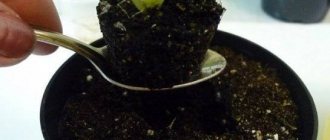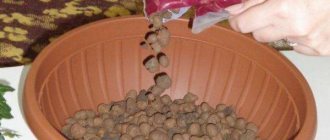Subscribe
“I give up!” due to problems with care
Problems with light
Violet loves light. But you need to keep it out of direct sunlight so that it does not burn the sensitive plant.
Lack of lighting
Its Saintpaulias are felt from mid-autumn until the end of winter .
Although, of course, not in every home. For example, my retired mother has a light on all the time in the kitchen where there are violets. Probably because of this, not a single flowerpot has to be illuminated.
In my apartment in winter, the lights come on only early in the morning and late in the evening, when everyone gets home from school and work. This is not enough for violets, so I bought a phytolamp . This LED device draws little electricity, but it solves a lot of problems: in addition to violets, orchids, fuchsia, gardenia, and even early seedlings can “bask” under such a lamp.
If there is only one lamp, but there are many colors, human cunning can enhance the effect of the device:
- the window sill can be lined with foil (mirror light reflector);
- From the side of the room, install plywood covered with white paper.
A matte white reflector enhances lighting by 1.5 times, and a mirror one by 2 times.
By the way, such reflectors can be used without lamps; in autumn or spring they will enhance natural sunlight.
Saintpaulias need about 12 hours of light per day.
And one more thing: you can understand that your plant does not have enough sun by the way it stretches its leaves or its entire rosette towards the window .
Also, plants with too dense rosettes sometimes suffer from a lack of light. In it, some leaves shade others. Solution: thin out the rosette by removing the weakest or most ugly leaves.
Excessive lighting
Too powerful lighting (both in summer, on a southern window sill, and with “horse” doses from improper lighting, when, say, a regular incandescent lamp is used instead of a phytolamp) can harm the plant. As a reaction to the light suddenly falling on it, the violet sometimes raises its leaves, trying to defend itself. Especially when before that the flower grew in partial shade, and suddenly found itself moved to the summer southern window.
Look at the leaves: with too much light, the plant also often suffers from sunburn . They look like this:
And by the way, low-hanging lamps (which heat up during operation) can also cause such burns.
Watering problems
If a violet does not receive enough watering, its leaves wither.
If she regularly lacks fluid, she may pull herself upward. At the same time, its leaves may curl.
Problems with air temperature
Do you have a radiator that hangs just under the windowsill where you placed the violet? The plant may suffer from excess temperature.
Don't look at the thermometer hanging on the wall. Place this device on the windowsill. What will it show? Violets tolerate temperatures from 16 to 26 degrees. If the temperature near the pot is 26 degrees or higher, the plant suffers from heat shock. Other signs of Saintpaulia overheating will be brown spots on the leaves or their total yellowing.
Problems with dry air
If the leaves rise and curl, the reason may be dry air. It is believed that violets cannot be sprayed , only kept on a tray with wet expanded clay. But when I inherited several beautiful, but very neglected and terribly dusty flowers, I sprayed them every week. It was summer, it was hot, the sockets dried out instantly. Moreover, they were not blooming at that moment. Therefore, I am not so categorical about spraying these plants. But in the cold, and even the flowering rosettes, I still wouldn’t spray them.
Ground problems
A violet can also “give up” due to a violation of the acid-base balance in the soil. This crop needs slightly acidic soil (with a pH within 7). If it is sour or alkaline, the violet may get sick - the leaves will not only rise, but also curl, their color will fade, the buds will set, but will not bloom - they will fall off.
Although there are varieties that prefer acidic soil - they bloom more brightly in it.
Good soil for any violets comes from:
- leaf soil (it is sometimes called forest or garden soil, since this soil is prepared under a deciduous shrub or tree);
- turf land (or meadow land - harvested where grass has been growing for many years);
- sand, perlite, vermiculite, charcoal.
And if the leaves of the flower turn yellow, perhaps it is chlorosis , and the soil needs to be shed with iron chelate. With chlorosis, lightening “islands” between the green veins spread across the leaves:
Incorrect lighting
Saintpaulia is a delicate and sensitive flower that requires attention. One of the reasons why violet leaves rise up is improper lighting.
Lack of light
Saintpaulia quickly reacts to a lack of light by changing its appearance: it fades and fades.
To get as much sunlight as possible, the violet lifts its leaves up, the petioles become long and thin, the rosette loses its beauty and is shaped like a large spider.
The solution to the problem is to artificially increase the lighting time of violets to 14 hours a day. For this purpose, they are illuminated with fluorescent lamps. Improvement soon comes: new leaves grow in proportionate size and step by step displace the faded ones.
Leaves with elongated petioles are gradually removed and a neat rosette is formed.
In case of prolonged lack of lighting, Saintpaulia suffers from chlorosis (iron deficiency). This disease is characterized by:
- impaired chlorophyll production;
- reduction in photosynthetic activity;
- premature yellowing and falling of leaves;
- drying shoot tips;
- growth retardation;
- death of roots.
In such a situation, the flower needs full treatment using iron chelate.
Excessive illumination
The flower does not tolerate direct sunlight. Excess light causes the leaves to stretch upward, trying to cover the growing point from the sun. In the center the rosette thickens and becomes brittle.
The underside of the leaf blades becomes burgundy. Shortened pedicels are not able to break out and break easily. If you do not move the plant to another place, it will certainly die.
Violet loves diffused lighting. The best option for placing flowers is on an eastern or western windowsill. If located on the south side, the pot with Saintpaulia is shaded with a curtain on the window.
Violet lifts its leaves up: why and what to do?
- View the full image
Violet lifts its leaves up
The best varieties of violets, their features
Why does a violet lift its leaves up?
How to fix the problem?
How to properly care for a flower?
Among indoor ornamental plants, violet occupies a dominant place, despite some difficulties in growing and caring for it.
The tenderness of the plant and its appearance depend on the condition of the petals collected in rosettes. And the leaves only frame the beauty of the flowers, located around them. The velvety quality of the leaf blade and its bright greenery are inseparable from the beauty of the inflorescences. The flower discovered in Africa is called both Saintpaulia after the discoverer, and Usambara violet after the area where it was first discovered. After the discovery of the violet, breeders improved the plant so much that gardeners can choose varieties with miniature petals and large ones. And the color range of the plant is so diverse that you are amazed at the imagination of man and nature. The variety of shades affected not only the flower petals, but also the leaves. The decorative effect of indoor culture largely depends on their condition.
Incorrect temperature
Violets prefer to grow at room temperature +20 – 22℃. In such conditions, the plant is comfortable, it develops normally, blooms long and profusely. In a cooler room, the edges on the petals appear more expressive and brighter.
At temperatures from +28 to +30℃, violets usually:
- the number of flowers decreases;
- their size decreases;
- the border on the leaves disappears;
- leaves rise up.
If Saintpaulia is left in such conditions for a long time, it may die. In this case, a wide-open window, an air conditioner or a fan can help.
However, the plant does not tolerate drafts at all. The blast of cold winter air causes light, creamy spots to appear on the leaves. Excessive cooling causes root rot, which can be corrected by replanting.
How to properly care for a flower?
Proper care plays a big role in the development of indoor flowers. Violet requires a lot to fully develop.
- First of all, you need a small pot with optimal dimensions of 7x7 centimeters. The container must have drainage and nutrient soil with an optimal ratio of useful elements. If the composition is prepared independently, then the substrate contains peat, compost, and perlite. You can add coconut fiber for looseness.
- Water the violets as the top layer of soil in the pot dries. To prevent water from getting on the leaves, it is better to organize watering through a tray. Take water at room temperature, carefully settled.
- The violet is afraid of drafts and does not like heat. An air temperature of 16–18 degrees is enough for her.
- Feed the flower once a month. Flower growers believe that for fertilizer it is necessary to take one part of rotted manure, small sawdust from deciduous trees, and wood ash. After adding a little coarse river sand, add a teaspoon of ready-made fertilizer under the bush.
The violet will bloom all year round, delighting you with flowers and fresh foliage, if you properly care for it and provide the plant with comfortable conditions.
More information can be found in the video:
Dry air
Saintpaulias do not tolerate dry environments at all. They grow and bloom poorly. To protect the newly formed buds from drying out, violets raise their leaves. Therefore, it is not advisable to place pots with plants indoors in winter near heating devices and radiators.
Important! For good development of violets, a humidity of at least 50% is required.
Humidify the air by placing a vessel with water near the flower. An aquarium is quite appropriate in this case. Humidifiers are a very successful solution to the problem of dry air.
Why does a violet lift its leaves up?
The condition of the leaves of a houseplant will tell you a lot about what it is missing at the moment of development. A healthy violet has horizontal leaves. A rosette of flowers fits on them, like a miniature bouquet.
If the leaves have risen up, then the reason for this lies in:
- insufficient lighting or its one-sidedness
- dry indoor air
- frequent change of place where Saintpaulia grows
- depletion of soil in a pot
Depending on the amount of light, the plant begins to change the position of its growing point. When there is little daylight, the leaves stretch out, trying to get it. Direct sunlight leads to the fact that the violet begins to hide the growing point, covering it with the surface of the plates.
In winter, air humidity drops sharply, and Saintpaulias bloom poorly, and the leaves, rising, cover the formed buds from drying out.
The flower reacts to a change in location by raising its leaves. Only after getting used to some conditions, you have to adapt to others. A lack of nitrogen in the soil affects the condition of the leaves and their proper development.
Along with a change in the direction of the growth point of the leaf rosette, the leaf plate may twist. This situation is typical for poor soil in a pot. Often the foliage turns pale, dries out and falls off. Here, the cause of this situation may be infections or a pest attack on a houseplant.
Soil composition
Sometimes violet leaves not only grow upward, but also curl. This indicates poor soil. To solve the problem, the plant is fed with nitrogenous fertilizers after it has flowered.
When choosing soil, you need to remember that Saintpaulias love breathable, moisture-absorbing soil. It should be slightly acidic, closer to neutral.
Violet leaves rise up: why does this happen and what to do
I have been growing violets for many years, so I know: a healthy violet has leaves that grow to the sides, slightly drooping onto the sides of the pot, their leaves have good turgor, and with ideal care they also seem shiny. Sometimes the beauty of a plant deteriorates - for example, over time the stem lengthens, or even becomes twisted. But even such Saintpaulia can have healthy leaves and beautiful flowers. It’s worse when the bush suddenly freezes at the command “Hands up!” - with this he hints that he feels bad. And, until the violet is completely dead, it needs to be treated or surrounded with ideal care.
Varietal affiliation
In some violets, raised leaves are a varietal feature and do not indicate a defect in the plant. These varieties include:
- King's Ransom has dense green foliage and light pink, purple-edged inflorescences edged with white.
- Neptune's Jewels features large double and semi-double frilled star-shaped flowers in a light pink shade with a white edge. The rosette is formed by large green leaves stretched upward.
- Happy Feet features a bouquet of dark green leaves and star-shaped lavender blossoms edged with blue and flecked with red.
With proper care, Saintpaulias delight owners with their grace, variety of shapes and colors. However, violation of growing conditions leads to a change in their appearance: the plant takes on an unattractive appearance. To eliminate the problem, it is necessary to adjust the conditions of detention.
Features of the flower
Most novice gardeners do not understand why the leaves turn yellow. This is due to the physiological characteristics of the flower or infectious diseases. The occurrence of physiological changes is observed with improper care. The appearance of infectious diseases can only be observed on plants that have weakened immunity.
Violet is an unpretentious indoor flower. This is why gardeners notice most problems late. It is recommended to carefully inspect the crop daily, which will make it possible to determine the cause of yellowness.
Violet foliage is collected in rosettes that have the correct shape. There are flowers in the center of the rosette. The leaves are characterized by a horizontal position. It shouldn't rise. If violet flowering is not observed, then the foliage should also be in a horizontal position. The leaves of the indoor flower are green in color, the shade of which varies depending on the type of crop. If, upon examination, the florist determines that his violet does not differ from this description, then he should not worry. If discoloration and dryness around the edges appear, it is necessary to evaluate the quality of flower care, as well as the presence of diseases.
Violet leaves can turn yellow for a variety of reasons. They can only be determined if the florist regularly inspects the flower.
“Cutting off the head” of the bush
This plant needs to be rejuvenated . You can go the hard way - cut leaf cuttings, root each one and wait a long time for flowering. Or you can make it simpler by simply “chicking off” the plant’s root system and pushing the violet to grow a new one. Of course, after this it will need to be planted in a smaller pot than the old one.
Everything is done simply:
- The violet is cut with a small piece of the stem. Its roots don’t even need to be removed from the soil.
- The stem is trimmed around the edges, even if you do not see rot on it. The cut should be completely clean.
- Place the violet in a glass so that the stem is in water but the leaves are not. Be careful: the violet will begin to actively drink (especially in the first days) + the heat, and tomorrow its stem may be hanging in the air. It makes sense to check the plant every day and add more water if necessary.
In the video below, the girl shows the entire process of pruning and rooting a violet. But she sticks the plant directly into the ground and germinates it in a homemade greenhouse. I prefer to keep the flower in water for 2 weeks, like this:
And when the roots grow and seem worthy of trust, plant this flower in the soil.
But overall the video is very informative and useful:
Let's summarize
- If the leaves of Saintpaulia (indoor violet) stretch upward, this means that something is wrong with the plant. Most likely, an error was made in care.
- In most cases, the flower does not have enough lighting. This problem will be solved by purchasing a phytolamp.
- Less commonly, the cause of leaf stretching is excess light, improper watering, dry air in the room, or poorly selected soil.
- If the violet is old, perhaps its root system cannot properly nourish the bush, and pulling out the leaves is only the first “swallow”. It is better to rejuvenate such a plant by cutting off the entire old root system and growing a new one.
And sometimes the situation turns out to be diametrically opposite: the leaves do not stretch upward, but fall down and seem to wither. In this case, the problem may lie in the care. More details in this video:
“I give up!” due to problems with care
Problems with light
Violet loves light. But you need to keep it out of direct sunlight so that it does not burn the sensitive plant.
Lack of lighting
Its Saintpaulias are felt from mid-autumn until the end of winter .
Although, of course, not in every home. For example, my retired mother has a light on all the time in the kitchen where there are violets. Probably because of this, not a single flowerpot has to be illuminated.
In my apartment in winter, the lights come on only early in the morning and late in the evening, when everyone gets home from school and work. This is not enough for violets, so I bought a phytolamp . This LED device draws little electricity, but it solves a lot of problems: in addition to violets, orchids, fuchsia, gardenia, and even early seedlings can “bask” under such a lamp.
If there is only one lamp, but there are many colors, human cunning can enhance the effect of the device:
- the window sill can be lined with foil (mirror light reflector);
- From the side of the room, install plywood covered with white paper.
A matte white reflector enhances lighting by 1.5 times, and a mirror one by 2 times.
By the way, such reflectors can be used without lamps; in autumn or spring they will enhance natural sunlight.
Saintpaulias need about 12 hours of light per day.
And one more thing: you can understand that your plant does not have enough sun by the way it stretches its leaves or its entire rosette towards the window .
Also, plants with too dense rosettes sometimes suffer from a lack of light. In it, some leaves shade others. Solution: thin out the rosette by removing the weakest or most ugly leaves.
Excessive lighting
Too powerful lighting (both in summer, on a southern window sill, and with “horse” doses from improper lighting, when, say, a regular incandescent lamp is used instead of a phytolamp) can harm the plant. As a reaction to the light suddenly falling on it, the violet sometimes raises its leaves, trying to defend itself. Especially when before that the flower grew in partial shade, and suddenly found itself moved to the summer southern window.
Look at the leaves: with too much light, the plant also often suffers from sunburn . They look like this:











